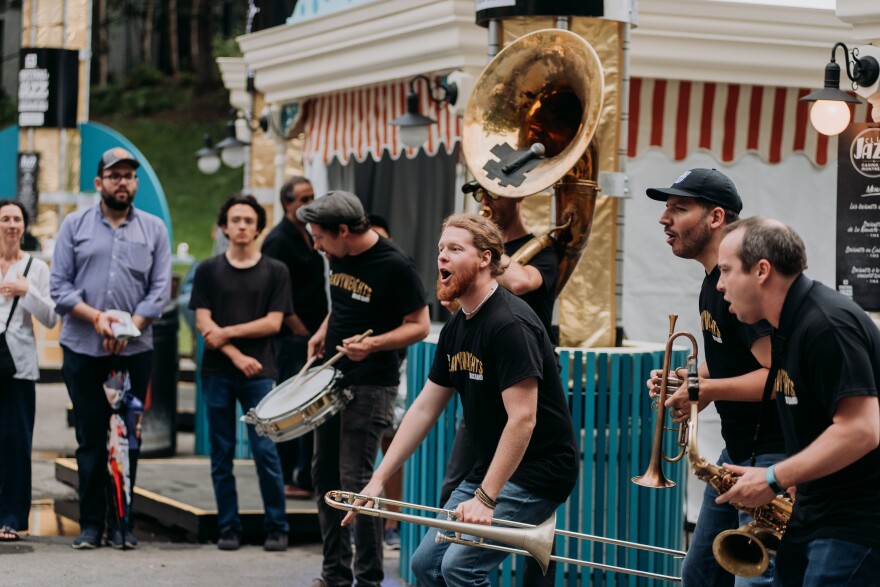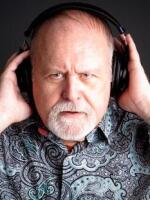Toujours ici -- I am always here.
At the jazzfest in Montreal. 26 years.
And it's not as if I've come back year after year. A plane to Montreal feels no different to me than a train to Newark.
I'm always at WBGO. It's where I live every day.
I'm always in Montreal. It's the same life.
This trip, right away, I've been hearing Charles Aznavour singing. All of the songs about time. Especially his song "Je n'ai pas vu le temps passer." "I have not seen the time go by."
Or his song "Hier Encore" ("Yesterday Again"). Became an American pop song 50-plus years ago. Translated back then into "Yesterday When I Was Young."
I was not young when I first came to Montreal. I was already in my mid-40's. I'd been traveling only since the latter 80's, mostly around Europe, mostly for jazz festivals. And for the lucky chance to get around the world. When opportunities to travel overseas fell through in the summer of 1972, I observed a full-page ad in DownBeat for the Montreal Jazz Festival.
Festival International de JAZZ de Montreal.
That they capitalized the word JAZZ in the festival's logo appealed to me.
And they welcomed me.
This trip, also immediately, I've been seeing changes. Everywhere.
They're terraforming for miles between the airport and the town. Alongside the highway, enormous mounds of earth and rocks, boulders even, have been unearthed and engineered into new re-routed roadways. And new buildings all around now almost eclipse some of my favorite landmarks. Like the green cupolas on church spires I see every year along the highway that tell me when I'm close to town. And high up on a skyscraper, headquarters of the energy conglomerate Hydro-Quebec, a giant brass Q -- with a lightning bolt as the letter's tail -- tells me I've arrived at the hotel.
When I first lived at the hotel, The Hyatt Regency was the Meredien. That then became the Desjardins. That then became the Wyndham. And over the years, now as the Hyatt Regency, it's become much more elegant.
This trip, and every trip, I always ask for a room on the "noisy" side, looking down and across Place des Arts, where music is happening noon to midnight, where even in the rain fest-goers squat on stairs. Or meander the festival food and beer kiosks. Or dance in the street.

Sunny though the day was, as I first came into my room a college big band was playing "The Gentle Rain." On the big Rio Tinto outdoor stage just below my room. On the 18th floor it's like an aerie of the festival. Looking down and to the right, I can see all around Place des Arts, the biggest cultural center of Canada. Looking left, I can see all 26 years of changes in the festival and the city.
Rue Jeanne-Mance, named for the nurse who opened the city's first hospital, used to be an artery for traffic alongside the arts center and mostly abandoned buildings. Showing how much FIJM means to the city, culturally and economically, the street became a year-round festival scene. They rebuild for each jazzfest the large TD Bank stage at one end of the street.
And for the jazzfest spectaculars, Les Grandes Evenements on that stage, as many as 100,000 fest-goers dance in the street.

Otherwise, day by day during the festival, a variety of delights happen in the street. A brass band or other groups play and parade. Mountebanks perform -- exotic stilt-walkers, jugglers, tumblers, fire-eaters.
And they have fountains -- frequently with kids laughing in the water spurting from the pavement.

One of the empty buildings became the Maison du Festival, complete with a restaurant, a jazz joint, a jazz archive and videoteque, a jazzfest museum, and the festival press room. Next to the jazz house is a brand-new edifice for dance and, newer, bigger, is an oddly-angled box of glass and steel also for the arts.
Construction is on-going everywhere, including at the hotel -- but, says a French proverb, the more things change, the more things are the same. Festival International de JAZZ de Montreal plays on. Hundreds of musical performances, in and around Place des Arts. Ticketed indoor concerts. Free outdoor concerts.

This trip, I'm game for all the gigs at Le Gesu, the Jesuit church around the corner from the festival Maison. I always want to end a festival day in the salle de Gesu, what I often call the Jesus Room. Intimate it is. Seats a few hundred of the always enthusiastic Montreal fest-goers, all of us close to the stage. One highlight of every festival is the "Invitation" series of concerts at 6PM. Invited are 2 or 3 artists for 2 or 3 gigs with different groups. John Medeski, Mark Guiliana, and Lonnie Smith are this year's "Invitees" -- although the first of the 6PM gigs was an extra: Jill Barber, a singer with a foot (or a tonsil) in a variety of styles. From jazz to pop. From pop to rock. Chops, she's got. And she's one of the friendliest performers I've ever heard. I especially enjoyed her lively feminist "Girl's Got To Do."
"Jazz dans la nuit" ("Jazz in the Night") happens at 10:30PM.. I've heard most of the best concerts through the years in the "Jesus Room." When I request from the (best in the world) press corps which concerts I want to attend, I don't always type the names of the artists. I just type "10:30, Gesu." I know that whoever is playing "dans la nuit" will be cool. And on opening night, Keyon Harrold was.
When he came out, Harrold's trumpet was ablaze. I right away was thinking Miles -- back when Miles was seriously rocking. I didn't know until he told the story: Harrold was what he called a "stunt double" for Don Cheadle playing Miles in Cheadle's bio-movie of Miles. Harrold also talked, deeply and forthrightly, about overcoming racism, especially in his hometown, Ferguson. He played a mournful (yet also hopeful) anthem of his own for an end to all hatred-ism. Shedrick Mitchell highlighted every moment he played acoustic and electric pianos, always with a bell-like touch. Harrold climactically blew the roof off with "She's Leaving Home," bittersweet when sung by the Beatles, incendiary when romped by Keyon Harrold.

John Medeski played the first of his Invitation concerts the next evening at 6PM with a full-tilt organ trio. Himself at a Hammond B-3, Medeski flashed and splashed across the keyboards with all the stops out, now gurgling, now whispering, now chortling, now screaming. Marc Ribot was featured on the guitar, plus drummer J.T. Lewis. Definitively they grooved, like avatars of Philly when funkiest.
Marius Neset played "in the night" with a quartet just ending a North American tour. They were exhausted, but there's a rarefied air for jazz in Montreal and all were enlivened. Neset, a tenor-and-soprano saxophonist from Norway, typifies the international artists that FIJM listens for all year round. His tunes were quirky but, with kaleidoscopic Anton Eger at the drums and Ivo Neame at the piano, were swinging. One highlight was composed for the very clicks of the sax keys, looped into echoing thrums as if heartbeats. Another highlight was Neset playing solo and virtually looping riffs by himself, reminding me of a solo concert I'll always remember of Michael Brecker in Montreal. Neset and the quartet climaxed with a herky-jerky melody that was more like a rhythm, with Eger's drums unleashed and with Neset's tenor anchoring the time.
And there's plenty more good time ahead at Festival International de JAZZ de Montreal.
--30--



